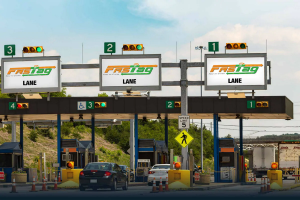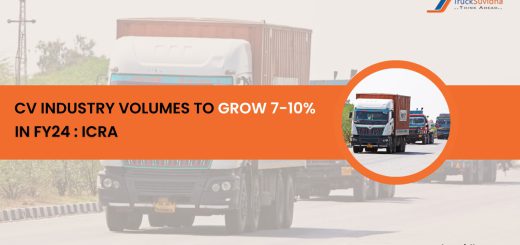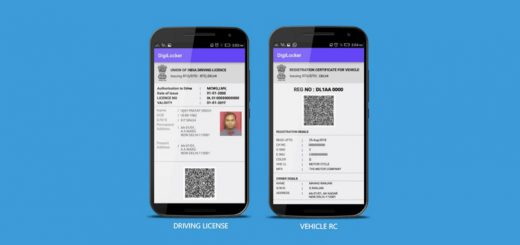FASTag: Datafication of India’s Tolls
FASTag itself is the brand name for the electronic toll collection (ETC) system operated by the National Payments Corporation of India (NPCI) along with various banks and Indian Highways Management Company Limited (IHMCL).
As India moves towards a toll-operate-transfer model, the success of FASTag, a data-intrusive centralised system, is a key piece in the whole puzzle.
From December 15, the government has decreed that all lanes in India’s national highways, barring one, will only accept cashless toll payments.
These ‘FASTag’ lanes penalise anybody who enters one and wants to use cash – they will be charged twice the toll amount.
Vehicles without the tag will still have the option of paying by cash in the lone lane that will exist across the 500-odd toll plazas that are part of the road network which comes under the National Highways Authority of India (NHAI).
Tolls that are part of state highways and tolled roads built by cities are not legally bound by the notification and might still insist on cash, have their own tags or have fewer FASTag lanes.
The ‘voluntary but effectively mandatory’ FASTag proposition will impact India’s economy in a number of ways.
While the evangelism around FASTags is one of purported convenience and reducing congestion, the state has multiple unstated aims which should concern all highway users.
This includes leveraging Big Data – aggregating electronic toll receipts at a national level – in order to help raise loans for infrastructure development through toll securitisation. The data crumbs that the FASTag network generates will also help the state in disinvesting public-funded highways and monetising highway assets.
The role of data and data governance theoretically plays a key role in all of these objectives, but it remains to be seen if datafication will help.
What and why
FASTag itself is the brand name for the electronic toll collection (ETC) system operated by the National Payments Corporation of India (NPCI) along with various banks and Indian Highways Management Company Limited (IHMCL).
The idea is that all vehicles will be fitted with an RFID tag that is linked to their wallet or bank account, and charges will be deducted as they pass through toll plazas, thus making them cashless.
The stated benefits of FASTag include decongesting India’s highways. The idea is that without each car having to pay cash, there will be faster movement through tolls. Other ancillary benefits include reduced fuel consumption, potentially less revenue leakage and increased transparency in processing toll transactions.
The technology and history
India’s highways have been the highly visible face of development, and ever since the National Highways Development Plan started its work, highways built under it have been largely financed by user fees through tolls. Along the way, we’ve had private investment come along with public partnership to build and manage these highways, some through debt, but all with the expectation that toll user fee collection will give returns to the capital instruments which financed them.
The Ministry of Road Transport and Highways (MoRTH), under UPA-II in 2010, set up a committee headed by Nandan Nilekani to study electronic toll collection systems.
It studied various systems across the world and laid down the technology and high-level roadmap for the project. An apex committee was then formed which suggested that a special purpose vehicle (SPV) be formed with strategic state control. It started a bidding process to select system integrators.
ICICI Bank won the bid and was appointed as central clearing house provider in February 2014. It was to be in charge of distributing RFID tags through their franchise network and manage clearing and settlement services to toll operators. The bid was selected based on who will provide maximum percentage of interest accrued out of idle money loaded on tags till they are used. ICICI had offered 176% of MIBOR (Mumbai Interbank Offered Rate) to IHMCL, 76 basis points more than what they would earn. When questioned, ICICI responded by saying they would be charging transaction charges from concessionaires as well – even though that was not mentioned in the project.
Documents obtained through Right to Information (RTI) requests suggest that ICICI was quoting much more (176%) than it could earn as charges.
IHMCL felt the ‘irrational’ bid was the reason ICICI was going slow on the project. It consequently served a notice for termination of agreement and in June 2014 additionally permitted Axis Bank to offer the same services at the same rate as ICICI to further FASTag, which in September 2014 became a common brand for electronic tolling service offered by different providers.
In August 2015, ICICI still grew slowly (2,200 tags issued across country) and Axis never commenced its services. MoRTH cancelled the entire project and suggested a single provider, preferably a public sector bank, to settle all electronic tolling and hire a consultant to rework the project. Among the reasons mentioned, apart from slow growth, was data not being with the government.
The project was reworked to make multiple banks issue tags and multiple banks partner with toll concessionaires to offer services. While it is unknown if there was a bidding process, NPCI, a private non-profit retail payments company run by banks, was awarded the role of clearing house to settle all toll transactions. It has been performing FASTag’s clearing house functions since November 2016, even though it got an official certificate of authorisation from the Reserve Bank of India to do so only in February 2019.
Meanwhile, there had been a steady push towards the use of FASTag, including mandating all new vehicles registered to have FASTag during registration from December 2017 onwards and later mandating all commercial vehicles to have them through permit rules in November 2018.
The final move has been to notify that users would need to pay double charge for making cash payments on all lanes except one which acts as hybrid lane, effectively forcing people to pay digitally.
Privatisation of cash
The FAStag system is complex. NPCI operates the ETC platform, while 22 banks are certified to issue the tags. Ten banks are certified to act as ‘acquirers’ and enter into contracts with individual concessionaires to support the installation of tag readers and provide acceptance infrastructure.
IHMCL, an SPV floated by MoRTH, with NHAI owning 41% and the rest owned by highway concessionaires and financial institutions, also issues bank-neutral FASTags, which can be bought online.
The electronic toll collection infrastructure is therefore effectively operated both by NPCI and IHMCL, with private and public sector banks, financial institutions and infrastructure companies as shareholders.
While IHMCL’s website doesn’t have mandatory disclosures required by the RTI Act, NPCI has argued successfully that it be exempt from the RTI in a case before the Central Information Commission, which dismissed the petition while accepting the company is not significantly controlled by the government.
While the commercial agreement was one of the reasons for the project to be reworked in 2015, under the new arrangement, a flat percentage of the toll charges go to IHMCL, NPCI and banks that operate this infrastructure.
For example, a car travelling from Tada to Nellore in Andhra Pradesh pays Rs 100 today for the toll by cash which goes to the concessionaire. However under FASTag, the bank which issued the tag (issuer) will get Rs 1.50, the bank that has partnered with the toll plaza gets Rs 1.25, IHMCL gets Rs 1 and NPCI gets Re 0.25. This adds up to 4% of revenue going to electronic toll infrastructure providers, similar to the ~2% merchant discount rate (MDR) on card payments.
Even though there is a 2.5% cash back to promote usage of FASTag, these will dry up after marketing spends go down and eventually, toll concessionaires will inflate toll charges by 4% to compensate for the cost, something that will impact not just car owners, but every citizen consuming goods transported through national highways.
Some issuers also charge a convenience fee, along with the Goods and Services Tax, for loading their FASTag wallets based on the mode of recharge.
This effectively requires India’s vehicle owners to pay before they can pay the actual highway toll. The cost of digitising India’s toll collection is squarely put on users, while there are unstated benefits that go to the state and its industry friends.
These costs are not just transactional, monetary and personal in nature. There are also long-term costs through data, privacy of individuals and economic interests of the state.
Source: http://bit.ly/2EerVqw





Recent Comments